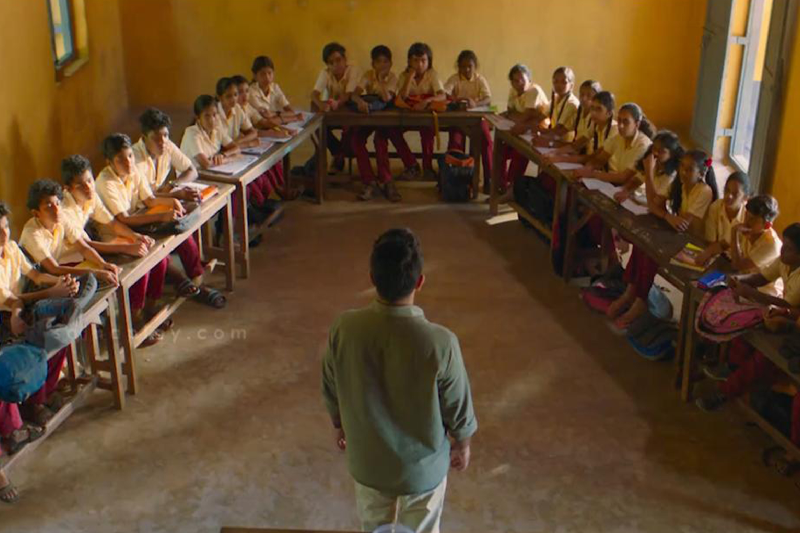
No More Back Benchers: Kerala Schools Redesign Classrooms Inspired by Malayalam Film 'Sthanarthi Sreekuttan'
In a refreshing shift toward inclusive education, several schools across Kerala are redesigning their classrooms to eliminate the age-old hierarchy of “front benchers” and “back benchers.” Inspired by a climactic scene in the Malayalam movie Sthanarthi Sreekuttan, these schools are adopting a U-shaped seating arrangement where every student is visible to the teacher and equally engaged in the learning process.
The idea, originally a cinematic detail in filmmaker Vinesh Viswanath’s directorial debut, has now become a reality in classrooms from Kollam to Kannur. The move is being widely appreciated for its potential to boost participation, attentiveness, and inclusivity among students.
From Silver Screen to School Rooms
Released in theaters on November 22, 2024, and later made available for streaming on June 20, Sthanarthi Sreekuttan is a Malayalam film that follows the story of four mischievous students navigating school life. In the film’s emotionally resonant climax, the classroom is shown with a semi-circular seating arrangement, symbolizing unity, transparency, and collective growth.
This scene struck a chord with educators. Without fanfare or formal policy direction, schools began implementing the setup shown in the movie, capturing photos of their restructured classrooms and tagging @vinesh_viswanath.zip, the director’s Instagram handle. This organic adoption came as a surprise to Viswanath, who was touched to see his artistic vision sparking tangible educational reform.
The U-Shape: Ending the Back Bench Divide
In the newly adopted format, students are seated in a U-formation, with the teacher positioned at the open end of the U. This eliminates the concept of “backbenchers”, ensuring that every student faces the teacher and each other. No one is hidden at the back; every child becomes part of the classroom dynamic.
This approach offers multiple benefits:
- Increased teacher visibility and student monitoring
- Greater classroom interaction
- Improved student attention and inclusion
- Encouragement for shy or quiet students to participate
The structure also creates a sense of equality. With no physical “front” or “back,” every student receives equal focus — removing the psychological stigma often associated with backbenchers as less attentive or underperforming.
Early Adopters Across Kerala
One of the first schools to implement this innovative seating layout was RVV HSS, Valakom, in the Kollam district. Their pioneering move gained attention locally and online. Since then, several other schools have followed suit, including:
- Pappinisseri West LP School, Kannur
- Andoor ALP School, Kannur
- RCC LPS East Mangad, Thrissur
- GHSS at Tholanur, Palakkad
- NSV VHSS, Valacode, Kollam
These institutions represent a growing list of schools that recognize the power of environmental design in educational outcomes. The new layout has been well received by both teachers and students, and several educators have noted early signs of improved classroom dynamics.
A Director’s Accidental Educational Impact
Filmmaker Vinesh Viswanath never anticipated the influence his movie would have beyond the world of cinema. He discovered the trend when schools began tagging him in photos of their revamped classrooms. What began as a visual storytelling element has now become a symbol of inclusive education in Kerala.
Viswanath’s response has been one of humility and excitement. While the director aimed to create a memorable narrative moment, seeing his work influence real-life educational change is a testament to how art can inspire action, especially when it resonates with deeper societal values.
Looking Ahead: Rethinking the Classroom
The adoption of this U-shaped seating arrangement is part of a larger shift in pedagogical thinking. Increasingly, educators are recognizing that classroom environments — including seating — play a critical role in shaping student engagement, mental well-being, and academic success.
In a traditional classroom, physical distance from the teacher often corresponds with reduced attention or participation. This new model dissolves those barriers, facilitating greater interaction between students and teachers alike.
By prioritizing visibility, equality, and collaboration, Kerala schools are setting a compelling example of how small structural changes can drive big improvements in learning culture.
Conclusion: No More Back Rows, No One Left Behind
As Kerala continues to innovate in education, the adoption of the U-shaped seating layout marks a significant step toward creating more inclusive, attentive, and student-centered classrooms. Inspired by cinema, driven by educators, and embraced by students — this transformation reflects a progressive mindset that sees every child as deserving of equal opportunity to learn and shine.
In classrooms that once had clear divisions, there is now unity in shape and spirit — and it all started with a scene in a movie.


